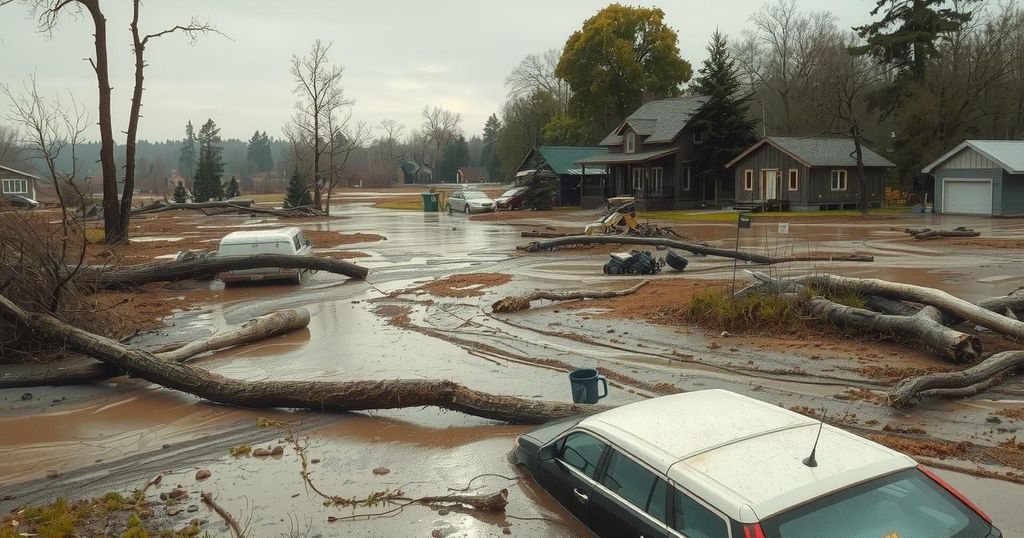Death Toll in South Africa Floods Rises to 78

The death toll in South Africa’s Eastern Cape floods has risen to at least 78. Heavy rains and strong winds devastated the region, submerging houses and leaving many homeless. Rescue teams are recovering bodies and are concerned about more victims as operations continue. The government warns of additional weather threats and the urgent need to relocate communities at risk.
In a tragic turn of events, the ongoing severe weather in South Africa’s Eastern Cape has now claimed at least 78 lives. The region, which has been targeted by heavy rains and powerful winds since Monday, saw rivers overflow their banks, flooding homes and toppling makeshift dwellings. The Mthatha area, situated 800 kilometers south of Johannesburg, appears to be the hardest hit, with residents working tirelessly to salvage belongings from their devastated homes days after the storm struck.
Rescue efforts remain intensive as teams have been recovering bodies. Reports indicate that officials discovered four bodies from a small one-room house as local residents gathered nearby. Caroline Gallant, the Eastern Cape manager at the South African Red Cross Society, noted that over 3,000 houses have suffered damage. “This is the worst ever disaster recorded in the area,” she stated, emphasizing the dire situation unfolding in the region. The death toll includes six students who were swept away in a school van, four of whom are still unaccounted for.
In a press briefing, Velenkosini Hlabisa, the minister of cooperative governance, confirmed the rising tally, stating, “The figure has gone to 78.” The Basic Education Minister, Siviwe Gwarube, shared concerning updates, revealing that “we learned of an additional two learners today… who have been confirmed as having died on the walk to school. We are reeling,” she added, showcasing the widespread emotional toll this disaster has inflicted on the communities.
The Gift of the Givers Foundation, a disaster response charity, has been instrumental with their efforts. Ali Sablay, the group’s spokesperson, informed that they recovered eight additional bodies, including three children, on Thursday evening. In light of the catastrophe, President Cyril Ramaphosa described the floods as “unprecedented” and has plans to visit the affected areas.
Rescue workers continue their search operations, going house to house. One rescuer, who opted to remain unnamed due to media restrictions, expressed concern over potentially finding more victims or survivors. “Yesterday we found people locked inside houses who couldn’t get out and were deceased,” he shared.
With infrastructure severely impacted, including damage to power and water supplies, about 600 individuals have been displaced, and many are seeking shelter in community centers. The local government highlighted that at least 20 healthcare facilities also sustained damage, complicating the rescue and recovery process. Sablay warned that “the numbers will increase dramatically,” as they noted a surge in people needing assistance, doubling from 5,000 to 10,000 in the past day alone.
The forecast is discouraging, with further extreme weather predicted across South Africa. Hlabisa reiterated the urgent need for action regarding vulnerable populations. “We must take a tough stance that everyone who is living on a flood plain must be removed,” he asserted, recognizing the harsh realities of climate change. The Eastern Cape is among the poorest provinces in the country, with a staggering 72% of its inhabitants living below the poverty line. The Green Climate Fund reports that South Africa faces significant threats from climate variability, with increased risks of floods, droughts, and wildfires becoming more commonplace.
The floods in South Africa’s Eastern Cape have resulted in a devastating death toll of at least 78 and left thousands homeless, underscoring the region’s vulnerability to extreme weather events. Rescue operations continue, with more bodies being discovered as recovery efforts progress. The situation is dire, with housing, infrastructure, and health facilities heavily impacted. Government authorities are warning of potential additional weather threats and advocating for the relocation of vulnerable populations from flood-prone areas due to the harsh realities posed by climate change.
Original Source: thepeninsulaqatar.com






